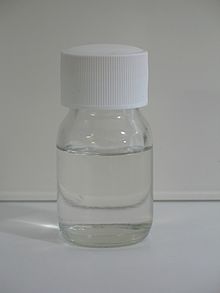| |||

| |||

| |||
| Names | |||
|---|---|---|---|
| Preferred IUPAC name
Acetyl chloride[2] | |||
| Systematic IUPAC name
Ethanoyl chloride | |||
| Other names
Acyl chloride
| |||
| Identifiers | |||
3D model (JSmol)
|
|||
| 605303 | |||
| ChEBI | |||
| ChemSpider | |||
| ECHA InfoCard | 100.000.787 | ||
| EC Number |
| ||
| 1611 | |||
PubChem CID
|
|||
| RTECS number |
| ||
| UNII | |||
| UN number | 1717 | ||
CompTox Dashboard (EPA)
|
|||
| |||
| |||
| Properties | |||
| CH3COCl | |||
| Molar mass | 78.49 g/mol | ||
| Appearance | Colorless liquid | ||
| Density | 1.104 g/ml, liquid | ||
| Melting point | −112 °C (−170 °F; 161 K) | ||
| Boiling point | 52 °C (126 °F; 325 K) | ||
| Reacts with water | |||
| -38.9·10−6 cm3/mol | |||
| Structure | |||
| 2.45 D | |||
| Hazards | |||
| GHS labelling: | |||
  
| |||
| Danger | |||
| H225, H302, H314, H335, H412 | |||
| P210, P233, P240, P241, P242, P243, P260, P261, P264, P270, P271, P273, P280, P301+P312, P301+P330+P331, P303+P361+P353, P304+P340, P305+P351+P338, P310, P312, P321, P330, P363, P370+P378, P403+P233, P403+P235, P405, P501 | |||
| NFPA 704 (fire diamond) | |||
| Flash point | 4 °C (39 °F; 277 K) | ||
| 390 °C (734 °F; 663 K) | |||
| Explosive limits | 7.3–19% | ||
| Related compounds | |||
Related acyl chlorides
|
Propionyl chloride Butyryl chloride | ||
Related compounds
|
Acetic acid Acetic anhydride Acetyl bromide | ||
Except where otherwise noted, data are given for materials in their standard state (at 25 °C [77 °F], 100 kPa).
| |||
Acetyl chloride (CH3COCl) is an acyl chloride derived from acetic acid (CH3COOH). It belongs to the class of organic compounds called acid halides. It is a colorless, corrosive, volatile liquid. Its formula is commonly abbreviated to AcCl.
- ^ Merck Index, 11th Edition, 79.
- ^ Nomenclature of Organic Chemistry : IUPAC Recommendations and Preferred Names 2013 (Blue Book). Cambridge: The Royal Society of Chemistry. 2014. pp. 796–797. doi:10.1039/9781849733069-FP001. ISBN 978-0-85404-182-4.


